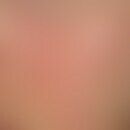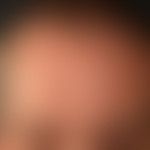Synonym(s)
DefinitionThis section has been translated automatically.
Variant of linear/ligamentous circumscribed scleroderma with localization on the head (most frequently in the forehead area with involvement of the parietal bone) with varying degrees of growth inhibition of the underlying bone. Mostly unilateral occurrence, but also occurring in the middle of the forehead and also multiple occurrences (see Fig.).
ManifestationThis section has been translated automatically.
Preference is given to a pediatric clientele with a mean age of 10 years. The first manifestation in early adulthood is rarer.
You might also be interested in
LocalizationThis section has been translated automatically.
Mainly localized frontoparietally. Usually unilateral, paramedian, but localized in the middle of the forehead area, extending into the hairy scalp. It is unclear whether the linear course follows nerves, vessels or Head's zones.
Clinical featuresThis section has been translated automatically.
Streak- or band-shaped, 1-4 cm wide, initially livid, asymptomatic, smooth, shiny, initially flat erythema. Over the course of months, the surface depresses in a trough or channel shape. The epidermis appears smooth and shiny, follicular structures gradually disappear. The color of the lesion changes in the center to a porcelain-like whitish-grey. The consistency is significantly increased in the center. The edges usually appear in a light brownish tone. Very frequently, the linear circumscribed scleroderma crosses the forehead-hairline. Infestation of the capillitium leads to lesional, irreversible "scarring" alopecia. As the skull grows, the sclerotic zone sinks in with pronounced furrowing.
HistologyThis section has been translated automatically.
DiagnosisThis section has been translated automatically.
Characteristic clinical picture. There should be a neurological examination and an MRI of the skull to exclude CNS involvement.
Differential diagnosisThis section has been translated automatically.
In case of lateral seat: Hemiatrophia faciei progressiva. In case of exclusive affection of the capillitium, clinical picture of scarring alopecia (DD: alopecia areata, here always follicle detection).
Complication(s)This section has been translated automatically.
Neurological complications: headache, migraine. These complaints can precede the cutaneous changes for several months.
TherapyThis section has been translated automatically.
See below Scleroderma, circumscribed. Augmentation by means of lipoaugmentation is possible. Autologous fat grafting (Coleman's technique) offers a safe and simple approach for the treatment of linear scleroderma "en coups de sabre". With minimal manipulation of the harvested fat in combination with overcorrection of the defect, clinically satisfactory long-term results can be achieved (Ayoub R et al. (2021). Start treatment early to prevent permanent osseous changes.
External therapyThis section has been translated automatically.
In the acute inflammatory stage, topical glucocorticoids under occlusion may be used for a short time. Alternatively, topical calcineurin inhibitors (e.g., tacrolimus, pimecrolimus) can be used (strictest indication because of unclear long-term side effects!).
In the sclerotic stage, topical therapy with vitamin D3 analogues may induce additional softening of the focus. Similar to UVA1 therapy, vitamin D3 analogues lead to the induction of collagenase in fibroblasts.
Radiation therapyThis section has been translated automatically.
Internal therapyThis section has been translated automatically.
In acute phases, MTX can be used in combination with systemic glucocorticoids for several months in addition to external therapy and UVA1 irradiation. The indication must always be determined individually.
Operative therapieThis section has been translated automatically.
If sclerosis with alopecia has already occurred, the hairless area can be excised. Only a surgeon familiar with this clinical picture should perform this procedure.
Augmentation by means of lipoaugmentation is also possible. Autologous fat grafting offers a safe and simple approach for the treatment of linear scleroderma "en coups de sabre". With minimal manipulation of the harvested fat in combination with overcorrection of the defect, clinically satisfactory long-term results can be achieved (Ayoub R et al. (2021). The extent to which permanent osseous changes can be prevented using this technique remains to be seen.
If severe and deforming osseous deformity has occurred, appropriate elevation of the skull bone and, if necessary, reconstruction of the forehead or eye socket are possible in specialized centers.
Progression/forecastThis section has been translated automatically.
Note(s)This section has been translated automatically.
LiteratureThis section has been translated automatically.
- Ayoub R et al. (2021) Treatment of linear scleroderma "En coup de Sabre" with single-stage autologous fat grafting: A case report and review of the literature. J Cosmet Dermatol 20:285-289.
- Dirschka T et al. (2007) Surgical correction of scleroderma en coup de sabre by en bloc resection. Dermatology 58: 611-614
- Flores-Alvarado DE et al. (2003) Linear scleroderma en coup de sabre and brain calcification: is there a pathogenic relationship? J Rheumatol 30: 193-195
- Marzano AV et al. (2003) Localized scleroderma in adults and children. Clinical and laboratory investigations on 239 cases. Eur J Dermatol 13: 171-176
- Mertens JS et al. (2015) Disease recurrence in localized scleroderma: a
- retrospective analysis of 344 patients with paediatric- or adult-onset disease.
- Br J Dermatol 172:722-728
- Ostertag JU et al (1994) Bilateral linear tempoparietal scleroderma en coup de sabre. Dermatology 45: 398-401
- Polcari I et al. (2014) Headaches as a presenting symptom of linear morphea en coup de sabre. Pediatrics 134: e1715-1719 .
- Rai R et al. (2000) Bilateral en coup de sabre-a rare entity. Pediatr Dermatol 17: 222-224
- Sehgal VN et al (2002) En coup de sabre. Int J Dermatol 41: 504-505
- Skorochod R et al. (2022) Management Options for Linear Scleroderma ("En Coup de Sabre"). Dermatol Surg 48:1038-1045.
- Tollefson MM et al. (2006) En coup de sabre morphea and Parry-Romberg syndrome: a retrospective review of 54 patients. J Am Acad Dermatol 56: 257-263
Incoming links (1)
Scleroderma linear;Outgoing links (7)
Calcineurin inhibitors; Circumscribed scleroderma; Glucorticosteroids topical; Parry Romberg syndrome; Pimecrolimus; Tacrolimus; Uv rays;Disclaimer
Please ask your physician for a reliable diagnosis. This website is only meant as a reference.


























